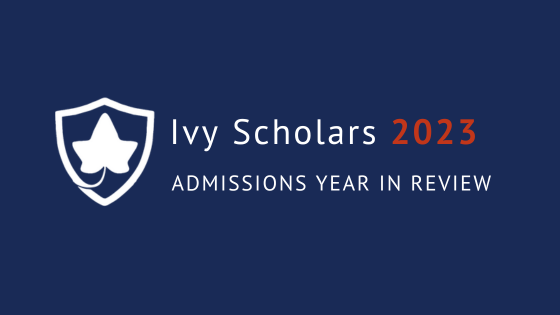Colleges have been sending out their admissions decisions, and we have begun the enjoyable work of counseling students on which of their admitted colleges is the best fit for them, and helping them prepare for the transition to college. We thought we’d take some time now at the end of the application process to go back through the year, and see what has occurred, both for overall admissions trends, and with Ivy Scholars students.
In this article we’ll cover broader trends in admissions, and what we’ve seen colleges doing. We’ll look not just at broader trends, but at how Ivy Scholars own students fared in admissions this year. FInally, we’ll look at what these trends might mean for you, and how they can impact your college planning. Let’s get started!
Admissions Trends in 2022-23
We did not see major shifts in the admissions landscape this year compared to previous, as we are slowly recovering from the unsettling effects of the Covid 19 pandemic. This does not mean the situation was static, but instead that we did not see seismic shifts. Here were the major trends we observed in admissions this year:
- Slight decreases in acceptance rates. Not every school saw a dip in acceptance rates, and there was a degree of fluctuation, but overall acceptance rates continued the slow downward trend we’ve observed over the past decades.
- Deferrals remain high. While the number of students taking a gap year has declined significantly since the first jump in 2020, it remains a popular option.
- An increase in waitlisted students. More students than ever found themselves on waitlists, as universities try to protect their yield.
- An increase in early acceptances. While some schools have long found a plurality or majority of their students in the early round, this trend continues to spread, with more schools admitting the bulk of their class through ED. This is again, to help colleges improve their yield numbers.
- Test-optional admissions continue. While the future is still uncertain, there is increasing evidence that colleges are enjoying test optional admissions, and they will be the norm for most schools going forward.
Another event is on the horizon, though the full extent of its impacts is as of yet uncertain. The Supreme Court’s ruling on affirmative action is expected this summer, and colleges are already beginning to plan and prepare for a major shift in the admissions landscape. While we have no way of knowing for sure what the decision will entail, we do expect there to be significant changes to admissions in the fall.
We will update you as we learn the impacts of this ruling, but all we can do now is watch and wait, both for how the justices rule, and for how colleges respond to the new ruling.
Ivy Scholars Results
Now that we’ve seen the general trends, let’s take a look at what Ivy Scholars students have accomplished. Here is a table with acceptance rates for Ivy Scholars students at top schools for the past year. Note that we are only including schools where we had a significant number of students apply, both for the sake of student privacy, and to ensure we publish meaningful data.
| School | Acceptance Rate | Ivy Scholars Acceptance Rate | Ivy Scholars Multiplier |
| Rice | 9% | 50% | 5.5 |
| Harvard | 4% | 20% | 5 |
| Yale | 5% | 20% | 4 |
| UCLA | 11% | 20% | 1.8 |
| UC Berkeley | 15% | 30% | 2 |
| Emory | 13% | 37.5% | 2.9 |
| Boston College | 19% | 67% | 3.5 |
| USC | 13% | 50% | 3.8 |
| Duke | 6% | 22% | 3.7 |
| Caltech | 4% | 33% | 8.3 |
| University of Virginia | 21% | 75% | 3.6 |
| Stanford | 4% | 14% | 3.5 |
| Princeton | 4% | 14% | 3.5 |
| MIT | 4% | 17% | 4.3 |
| UChicago | 6% | 25% | 4.2 |
| Dartmouth | 6% | 17% | 2.8 |
| Columbia | 6% | 17% | 2.8 |
These are remarkable results, and our students worked hard to achieve them. Here are some other noticeable trends we saw in admissions this year:
- UT Austin was more popular, and more competitive, than ever. We saw a significant number of students admitted to the CAP program, and it seems UT Austin added more students than ever to both that program and the waitlist, though we’re still waiting on official numbers.
- More students were waitlisted than in previous years, as schools admit fewer students and work to manage their yield.
- Applying Early Decision remains key, with many of our students getting admitted through the early rounds.
Most of our students chose to submit their standardized test scores with their applications (especially those who worked with us to prepare for the tests).
Overall, all of our students got into a top choice school, and we’re excited to see what they end up doing in the future, in college and beyond.
What College Trends Mean For You
So what do these trends mean for you, both our own and generally? First, while we did not see a major decline in acceptance rates, we did not see an increase either. Colleges remain historically competitive for admissions, with all top schools admitting less than 10% of applicants.
This means students are applying to ever more schools, and are working harder than ever to get in off the waitlist. We anticipate this continuing in the future, and more students need to make plans for what they will do if they are waitlisted by their top school. While it’s always good to remain optimistic, preparing for negative outcomes allows you to navigate through them more smoothly.
We anticipate colleges remaining test optional for several years, and believe most top schools will remain test optional indefinitely. While the SAT and ACT will remain important for admissions, the pandemic, and the years since, have shown colleges they can admit great incoming classes without requiring test scores. Most students admitted do submit scores however, and we will continue advising our students to prepare for and take the tests.
Finally, we will continue advising all of our students to apply in the early round if possible. As colleges seek to manage their yield, they increasingly admit students through binding early decision (or early decision II), leaving fewer and fewer spaces for students who are applying in the regular round.
Final Thoughts
This was an exciting year for college admissions, but not too momentous. While it looks like the future could hold changes, what we saw generally reflected the same trends we’ve seen in previous years.
We are excited by our students’ success, and hope that this review will help you when planning our own college journey. If you want help doing so, and want to learn how we can make your admissions path easier, schedule a free consultation today. We’d love to help you, and report on your success in years to come.








